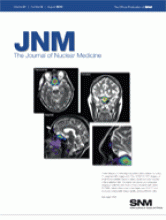REPLY: We greatly appreciate the interest of Dr. Nyman in our study (1), in which we concluded that ventilation–perfusion (V/Q) SPECT in combination with low-dose CT without contrast enhancement has excellent diagnostic performance in patients suspected of having pulmonary embolism (PE).
All patients were referred for a V/Q SPECT scan and therefore, as stated by Dr. Nyman, were preselected from the general cohort of patients suspected of having PE. The prevalence of patients excluded because of renal impairment was 24%, which compared favorably with the PIOPED II study (19%) (2). The conclusions from our study applied strictly to patients who could safely undergo CT angiography. Thus, whether the same results would be obtained in patients who cannot undergo CT angiography is unknown.
Dr. Nyman points out that using a lower dose of contrast medium and a lower kilovoltage could be sufficient for diagnostic CT angiography of the lungs. However, we chose to use a CT protocol that was the state of the art at that time (2) in order not to jeopardize the quality of the CT scans.
The lack of an independent gold standard for establishing a diagnosis of PE poses difficulties for evaluating and comparing the diagnostic accuracy of different modalities in PE. To compare the diagnostic performance of the tested modalities, we used a combination of composite and head-to-head consensus reading as the criterion standard. The use of this combined method that includes all tested modalities to classify PE patients raises methodologic and conceptual problems and is controversial. It is important to keep in mind that some patients may be incorrectly assigned to a disease category by the modality that is being studied, producing exaggerated or underestimated accuracies. This concern was also commented on in an invited perspective (3) on our study (1), published in The Journal of Nuclear Medicine. However, we believe that as long as the results are viewed in that respect, our approach can be justified and was the best available criterion standard.
In our report, we conclude that V/Q SPECT in combination with low-dose CT without contrast enhancement has an excellent diagnostic performance in patients suspected of having PE. Dr. Nyman speculates on whether the lower sensitivity of CT angiography of the lungs could benefit patients. Thus, the lower sensitivity of CT may be advantageous relative to SPECT, which may carry the risk of serious bleeding complications from treatment of clinically harmless PE. Several other studies have shown that after a negative pulmonary CT angiography result,3- to 6-mo mortality is low and an anticoagulant can be omitted. However, our study was not performed as an outcome study but to compare the diagnostic accuracies of V/Q SPECT, CT angiography, and V/Q SPECT in combination with low-dose CT.
The incidence of chronic thromboembolic pulmonary hypertension (CTEPH) is estimated at about 4% within 2 y for all patients surviving an episode of symptomatic idiopathic pulmonary embolism (4). Most cases of CTEPH may originate from asymptomatic venous thromboembolism (5), but it is not known how many patients with PE that is unobserved in the acute phase later develop CTPEH. We hypothesize that a more sensitive diagnostic modality has to be used in order for CTEPH not to develop.
- © 2010 by Society of Nuclear Medicine







